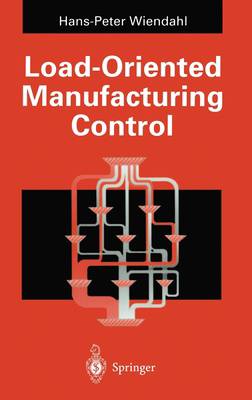
- Retrait en 2 heures
- Assortiment impressionnant
- Paiement sécurisé
- Toujours un magasin près de chez vous
- Retrait gratuit dans votre magasin Club
- 7.000.0000 titres dans notre catalogue
- Payer en toute sécurité
- Toujours un magasin près de chez vous
Description
1 Introduction.- 1.1 Preface.- 1.2 Changes in the Manufacturing Environment.- 1.2.1 Productivity.- 1.2.2 Flexibility.- 1.2.3 Attractiveness of the Workplace.- 1.3 Shifting Objectives of Manufacturing Control.- 1.4 Scheduling in Practice.- 1.5 The Weak Points of Conventional Manufacturing Control.- 1.6 References.- 2 Conventional Production Scheduling and Control.- 2.1 Abstract.- 2.2 Survey.- 2.3 Lead Time Scheduling and Capacity Scheduling.- 2.3.1 Single Steps in Lead Time Scheduling.- 2.3.1.1 Determining Lead Times.- 2.3.1.2 Interoperation Time Reduction.- 2.3.1.3 Operation Overlapping.- 2.3.1.4 Operation Splitting.- 2.3.2 Single Steps in Capacity Scheduling.- 2.3.2.1 Finite Loading.- 2.3.2.2 Capacity Adjustment.- 2.3.2.3 Capacity Alignment.- 2.4 Evaluation of Conventional Lead Time Scheduling.- 2.5 Requirements for New Methods of Production Scheduling and Control.- 2.6 References.- 3 Lead Time - A Key Term in Manufacturing Control.- 3.1 Abstract.- 3.2 Introduction.- 3.3 Lead Time Components.- 3.4 Simple and Weighted Mean Lead Time at a Work Center.- 3.5 Order Lead Times.- 3.6 Statistical Evaluation of Work Center Lead Times.- 3.6.1 Absolute and Relative Frequency Distribution of Simple and Weighted Lead Time.- 3.6.2 Simple and Weighted Mean Operation Time.- 3.6.3 Simple and Weighted Mean Operation Time Percentage.- 3.6.4 Median of Simple and Weighted Lead Time.- 3.6.5 Standard Deviation of Simple and Weighted Mean Lead Time.- 3.6.6 Coefficient of Variation of Simple and Weighted Lead Time.- 3.6.7 Median, Standard Deviation, and Coefficient of Variation of Simple and Weighted Order Time.- 3.7 Work Center Lead Time in the Shop Calendar.- 3.7.1 Transformation of Throughput Elements.- 3.7.2 Frequency Distribution and Statistical Evaluation in the Shop Calendar.- 3.8 Uncertainty of Measurement and Accuracy of Computed Lead Time Values.- 3.9 Examples of Authentic Lead Time Measurements.- 3.9.1 Work Center Lead Times.- 3.9.2 Operation Lead Times.- 3.9.3 Order Lead Times.- 3.10 References.- 4 The Throughput Diagram - A General, Realistic Model of the Manufacturing Process.- 4.1 Abstract.- 4.2 Historical Evolution.- 4.3 Basic Form of the Throughput Diagram.- 4.4 The Work Center Throughput Diagram and its Basic Data.- 4.4.1 How to Produce a Work Center Throughput Diagram.- 4.4.2 Mean Inventory.- 4.4.3 Mean Time Data.- 4.4.3.1 Mean Range.- 4.4.3.2 Mean Advance Time.- 4.4.3.3 Weighted Mean Lead Time.- 4.4.4 Relationships between Mean Range, Mean Advance Time, and Weighted Mean Lead Time.- 4.4.4.1 Inventory Trend Component of Lead Time.- 4.4.4.2 Sequence Component of Weighted Lead Time.- 4.4.4.3 Short- and Long-Term Relationships between Time Quantities.- 4.4.5 Mean Performance, Mean Capacity, and Mean Utilization.- 4.4.6 Relationships between Mean Inventory, Mean Performance, and Weighted Mean Lead Time.- 4.4.7 Weighted Mean Lateness.- 4.5 Order Throughput Diagram.- 4.5.1 Extended Work Center Throughput Diagram.- 4.5.2 How to Produce the Order Throughput Diagram.- 4.6 References.- 5 Analysis, Monitoring, and Diagnosis of the Manufacturing Flow.- 5.1 Abstract.- 5.2 Manufacturing Flow Monitoring.- 5.3 Manufacturing Flow Analysis.- 5.3.1 Procedure Outline.- 5.3.2 Forms of Evaluation and Representation.- 5.3.3 Representation of the Results.- 5.3.4 General Rules and Possibilities for Improving Manufacturing Flow.- 5.4 A Continuous Monitoring System for Manufacturing Flow.- 5.4.1 Objectives and Concept.- 5.4.2 Example of a Continuous Monitoring System.- 5.4.3 Results and Use of a Continuous Monitoring System.- 5.5 Diagnosis of the Manufacturing Flow in the Throughput Diagram.- 5.5.1 Breaking down Inventories.- 5.5.2 Breaking down Lead Times.- 5.5.3 Measures to be Deduced from Monitoring and Diagnosis Results.- 5.6 Use of Graphics for the Representation of Throughput Diagrams and Key Data.- 5.6.1 Representation of the Results of Manufacturing Analyses.- 5.6.2 Graphics for Medium-Term Manufacturing Flow Monitoring.- 5.7 Implications for Manu...
Spécifications
Parties prenantes
- Auteur(s) :
- Editeur:
Contenu
- Nombre de pages :
- 388
- Langue:
- Anglais
Caractéristiques
- EAN:
- 9783540197645
- Date de parution :
- 19-12-94
- Format:
- Livre relié
- Format numérique:
- Genaaid
- Dimensions :
- 156 mm x 234 mm
- Poids :
- 716 g

Seulement chez Librairie Club
+ 366 points sur votre carte client de Librairie Club
Les avis
Nous publions uniquement les avis qui respectent les conditions requises. Consultez nos conditions pour les avis.






